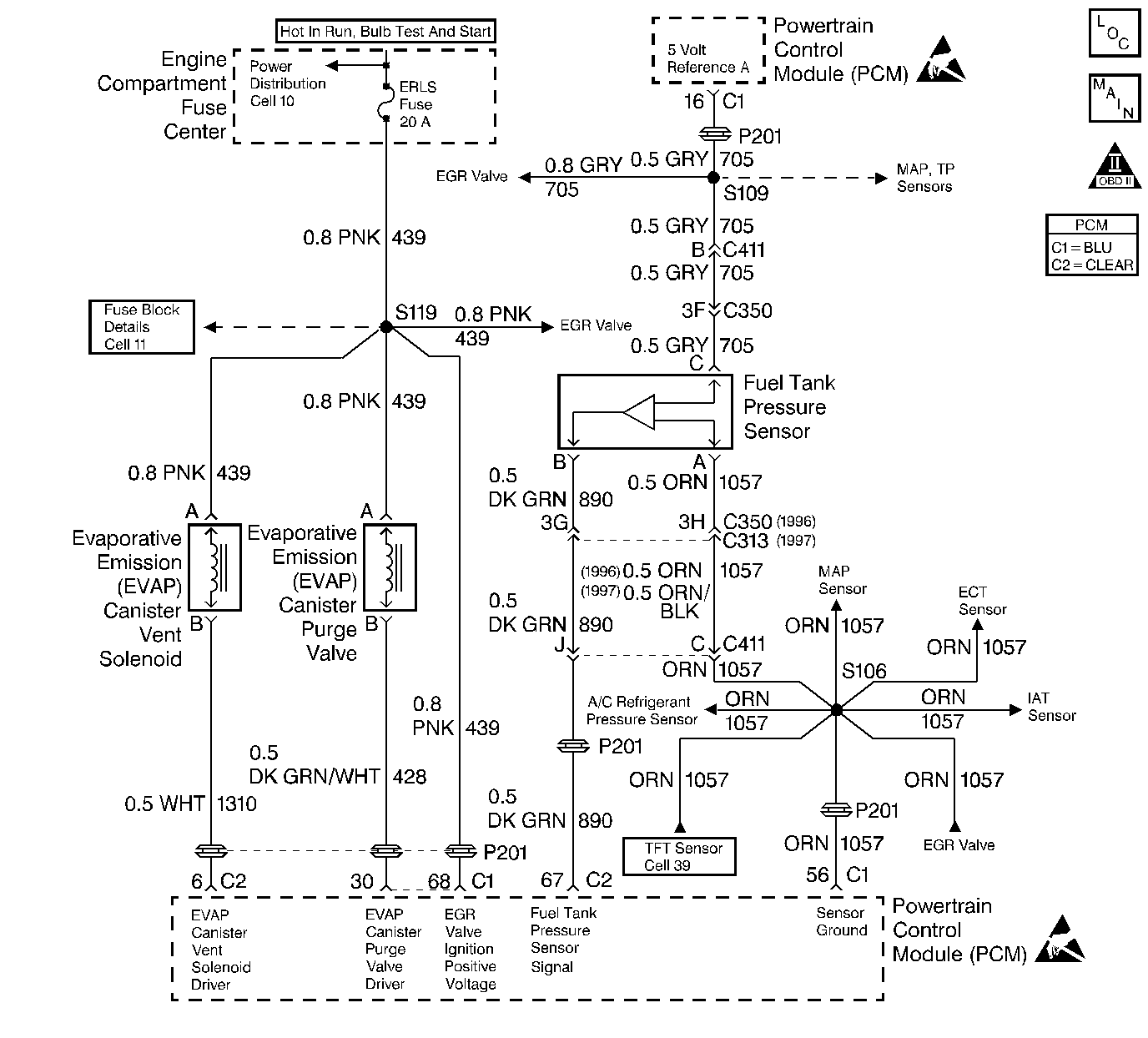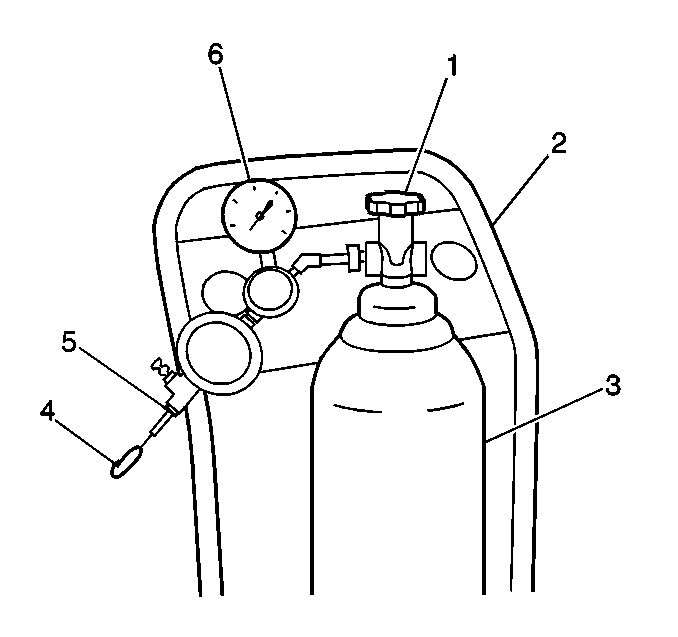
Circuit Description
The evaporative system includes the following components:
| • | The fuel tank. |
| • | The EVAP vent solenoid. |
| • | The fuel tank pressure sensor. |
| • | The fuel pipes and hoses. |
| • | The fuel cap. |
| • | The EVAP vapor lines. |
| • | Ther EVAP purge lines. |
| • | The evaporative emission canister. |
| • | The EVAP purge solenoid. |
A restricted or blocked EVAP vent path is detected by monitoring fuel tank pressure during normal operation (EVAP vent solenoid open, EVAP purge solenoid normal). With the EVAP vent solenoid open, vacuum level in the system should be very low unless the vent path is blocked. A blockage can be caused by the following conditions:
| • | Faulty EVAP vent solenoid (stuck closed). |
| • | Plugged kinked or pinched vent hose. |
| • | Shorted EVAP vent solenoid driver circuit. |
| • | Plugged evaporative canister. |
An incorrect fuel tank pressure sensor signal is detected by monitoring fuel tank pressure when the key is first turned ON during a cold start. If the fuel tank pressure signal is out of range, the EVAP diagnostic will not be able to detect leaks.
If any of the conditions described above are present, DTC P0446 will set.
Conditions for Setting the DTC
| • | No TP sensor, ODM, IAT sensor, or MAP sensor DTCs set. |
| • | Start up engine coolant temperature is between 4°C and 30°C (40°F and 86°F). |
| • | Start up engine coolant temperature not more than 8°C (14°F) greater than start up intake air temperature. |
| • | Start up Intake air temperature is between 4°C and 30°C (40°F and 86°F). |
| • | Start up intake air temperature not more than 2°C (4°F) greater than start up engine coolant temperature. |
| • | Fuel tank level is between 15% and 85%. |
| • | BARO is greater than 75 kPa. |
| • | Fuel tank pressure is not between -1.5 and 1.5 in. H2O when the ignition is turned ON. |
OR
| • | No TP sensor, ODM, IAT sensor, or MAP sensor DTCs set. |
| • | DTC P0442 diagnostic test has passed. |
| • | Normal system operation is commanded (EVAP vent solenoid open, EVAP purge solenoid normal). |
| • | Fuel tank pressure is less than -10 in. H2O. |
| • | Above conditions present for up to 30 seconds. |
Action Taken When the DTC Sets
Important: Although these diagnostics are considered type A, they act like type B diagnostics under certain conditions. Whenever the EVAP diagnostics report that a system has passed, or if the battery has been disconnected, the diagnostic must fail during 2 consecuitive cold start trips before setting a DTC. The initial failure is not reported to the diagnostic executive or displayed on a scan tool. A passing system always reports to the diagnostic executive immediately.
| • | The PCM will illuminate the MIL during the first trip in which the diagnostic test has been run and failed. |
| • | The PCM will store conditions which were present when the DTC set as Freeze Frame and Fail Records data. |
Conditions for Clearing the MIL/DTC
| • | The PCM will turn OFF the MIL during the third consecutive trip in which the diagnostic has been run and passed. |
| • | The History DTC will clear after 40 consecutive warm-up cycles have occurred without a malfunction. |
| • | The DTC can be cleared by using the scan tool. |
Diagnostic Aids
Check for the following conditions:
| • | Poor connection at PCM. |
| Inspect harness connectors for backed out terminals, improper mating, broken locks, improperly formed or damaged terminals, and poor terminal to wire connection. |
| • | Damaged harness. |
| Inspect the wiring harness to the EVAP vent solenoid and the fuel tank pressure sensor for an intermittent open or short circuit. |
| • | Kinked, pinched or plugged vent hose. |
| Verify that the vent hose between the canister and the EVAP vent solenoid is not restricted. |
Reviewing the Fail Records vehicle mileage since the diagnostic test last failed may help determine how often the condition that caused the DTC to be set occurs. This may assist in diagnosing the condition.
Test Description
Number(s) below refer to the step number(s) on the Diagnostic Table.
-
If a vent solenoid electrical fault is present, the purge system will not operate correctly. Repairing the electrical fault will very likely correct the condition that set DTC P0446.
-
Checks the Fuel Tank Pressure sensor at ambient pressure.
-
Verifies that the fuel tank pressure sensor accurately reacts to EVAP system pressure changes.
-
Checks for a blocked EVAP canister.
Step | Action | Value(s) | Yes | No |
|---|---|---|---|---|
1 | Was the Powertrain On-Board Diagnostic System Check performed? | -- | Go to the Powertrain OBD System Check | |
Is DTC P1675 also set? | -- | Go to DTC P1675 EVAP Vent Solenoid Control Circuit | ||
Is Fuel Tank Pressure at the specified value? | 0 in. H2O | Go to EVAP Control System Diagnosis - Fuel Tank Pressure Sensor Check | ||
|
Important: : Before continuing with diagnosis, zero the EVAP Pressure and Vacuum
(inches of H2O) gauges on the
Is Fuel Tank Pressure at the specified value? | 5 in. H2O | Go to EVAP Control System Diagnosis - Fuel Tank Pressure Sensor Check | ||
5 |
Does EVAP pressure return to the second specified value within 5 seconds? | 5 in. H2O 0 in. H2O | Refer to Diagnostic Aids | |
Does the vacuum remain less than the specified value? | - 45 in. H2O | |||
7 |
Was a problem found? | -- | ||
8 | Replace the EVAP vent solenoid. Refer to EVAP Vent Valve. Is action complete? | -- | -- | |
9 | Replace the EVAP canister. Refer to EVAP Canister. Is action complete? | -- | -- | |
10 |
Does EVAP pressure return to the second specified value within 5 seconds? | 5 in. H2O 0 in. H2O | System OK |

